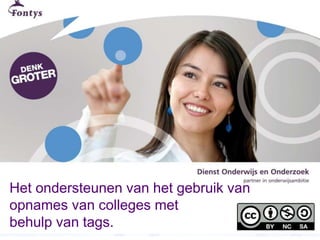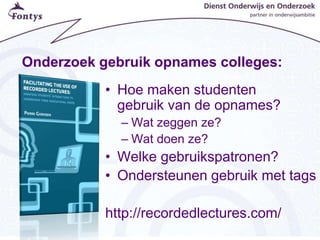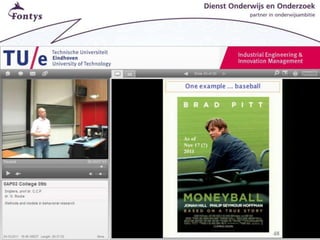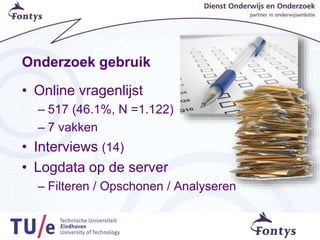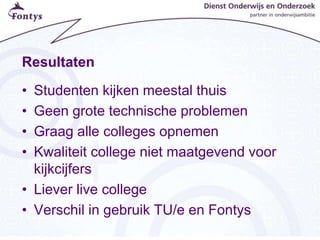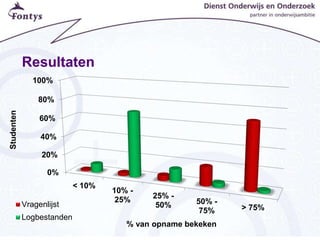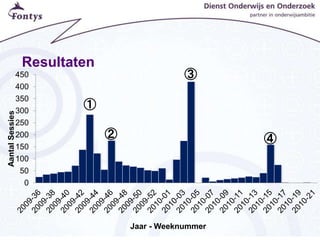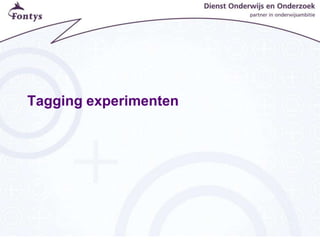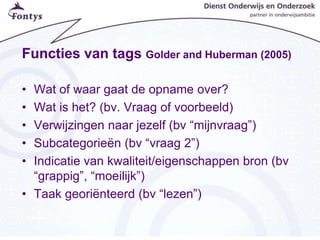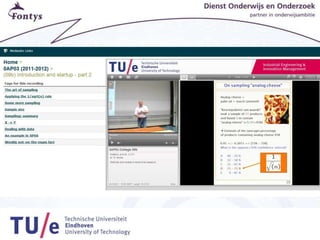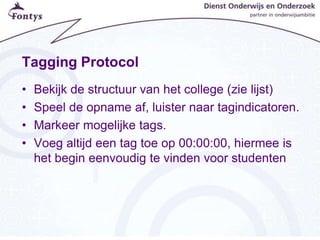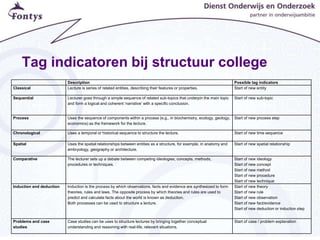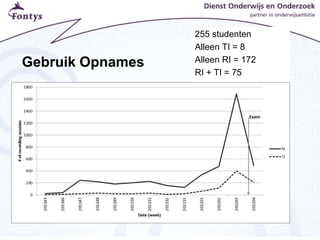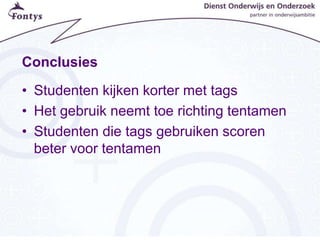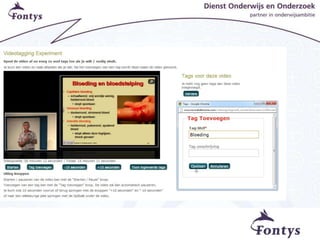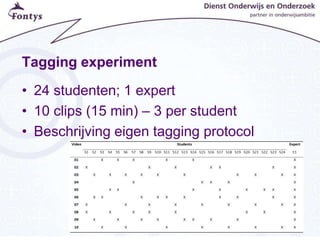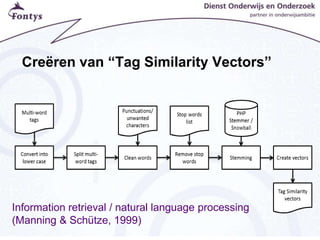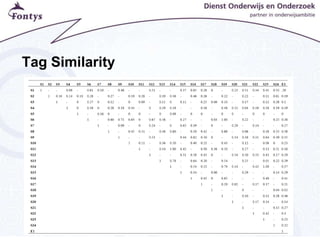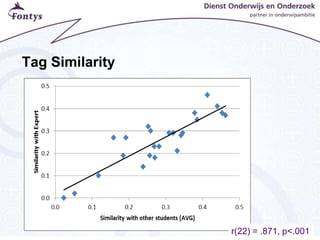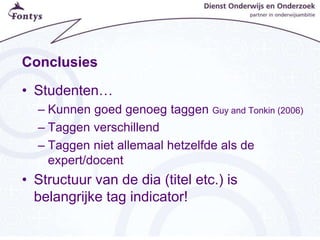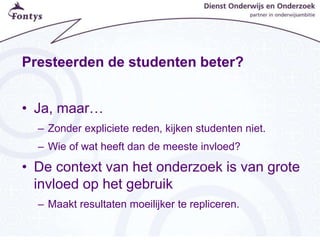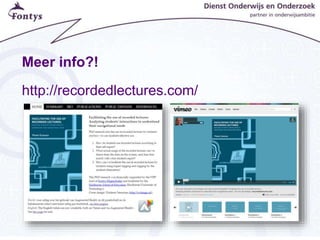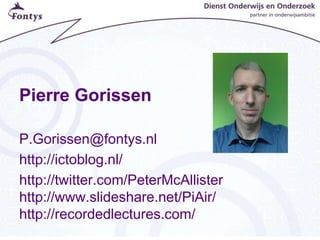Het ondersteunen van het gebruik van opnames van colleges met behulp van tags
- 1. Het ondersteunen van het gebruik van opnames van colleges met behulp van tags.
- 2. Onderzoek gebruik opnames colleges: ŌĆó Hoe maken studenten gebruik van de opnames? ŌĆō Wat zeggen ze? ŌĆō Wat doen ze? ŌĆó Welke gebruikspatronen? ŌĆó Ondersteunen gebruik met tags http://recordedlectures.com/
- 4. Onderzoek gebruik ŌĆó Online vragenlijst ŌĆō 517 (46.1%, N =1.122) ŌĆō 7 vakken ŌĆó Interviews (14) ŌĆó Logdata op de server ŌĆō Filteren / Opschonen / Analyseren
- 5. Resultaten ŌĆó Studenten kijken meestal thuis ŌĆó Geen grote technische problemen ŌĆó Graag alle colleges opnemen ŌĆó Kwaliteit college niet maatgevend voor kijkcijfers ŌĆó Liever live college ŌĆó Verschil in gebruik TU/e en Fontys
- 6. Resultaten 0% 20% 40% 60% 80% 100% < 10% 10% - 25% 25% - 50% 50% - 75% > 75% Studenten % van opname bekeken Vragenlijst Logbestanden
- 9. Functies van tags Golder and Huberman (2005) ŌĆó Wat of waar gaat de opname over? ŌĆó Wat is het? (bv. Vraag of voorbeeld) ŌĆó Verwijzingen naar jezelf (bv ŌĆ£mijnvraagŌĆØ) ŌĆó Subcategorie├½n (bv ŌĆ£vraag 2ŌĆØ) ŌĆó Indicatie van kwaliteit/eigenschappen bron (bv ŌĆ£grappigŌĆØ, ŌĆ£moeilijkŌĆØ) ŌĆó Taak geori├½nteerd (bv ŌĆ£lezenŌĆØ)
- 11. Tagging Protocol ŌĆó Bekijk de structuur van het college (zie lijst) ŌĆó Speel de opname af, luister naar tagindicatoren. ŌĆó Markeer mogelijke tags. ŌĆó Voeg altijd een tag toe op 00:00:00, hiermee is het begin eenvoudig te vinden voor studenten
- 12. Tag indicatoren bij structuur college Description Possible tag indicators Classical Lecture is series of related entities, describing their features or properties. Start of new entity Sequential Lecturer goes through a simple sequence of related sub-topics that underpin the main topic and form a logical and coherent ŌĆśnarrativeŌĆÖ with a specific conclusion. Start of new sub-topic Process Uses the sequence of components within a process (e.g., in biochemistry, ecology, geology, economics) as the framework for the lecture. Start of new process step Chronological Uses a temporal or historical sequence to structure the lecture. Start of new time sequence Spatial Uses the spatial relationships between entities as a structure, for example, in anatomy and embryology, geography or architecture. Start of new spatial relationship Comparative The lecturer sets up a debate between competing ideologies, concepts, methods, procedures or techniques. Start of new ideology Start of new concept Start of new method Start of new procedure Start of new technique Induction and deduction Induction is the process by which observations, facts and evidence are synthesized to form theories, rules and laws. The opposite process by which theories and rules are used to predict and calculate facts about the world is known as deduction. Both processes can be used to structure a lecture. Start of new theory Start of new rule Start of new observation Start of new fact/evidence Start of new deduction or induction step Problems and case studies Case studies can be uses to structure lectures by bringing together conceptual understanding and reasoning with real-life, relevant situations. Start of case / problem explanation
- 13. Gebruik Opnames 255 studenten Alleen TI = 8 Alleen RI = 172 RI + TI = 75
- 14. Conclusies ŌĆó Studenten kijken korter met tags ŌĆó Het gebruik neemt toe richting tentamen ŌĆó Studenten die tags gebruiken scoren beter voor tentamen
- 16. Tagging experiment ŌĆó 24 studenten; 1 expert ŌĆó 10 clips (15 min) ŌĆō 3 per student ŌĆó Beschrijving eigen tagging protocol
- 17. Cre├½ren van ŌĆ£Tag Similarity VectorsŌĆØ Information retrieval / natural language processing (Manning & Sch├╝tze, 1999)
- 18. Tag Similarity
- 19. Tag Similarity r(22) = .871, p<.001
- 20. Conclusies ŌĆó StudentenŌĆ” ŌĆō Kunnen goed genoeg taggen Guy and Tonkin (2006) ŌĆō Taggen verschillend ŌĆō Taggen niet allemaal hetzelfde als de expert/docent ŌĆó Structuur van de dia (titel etc.) is belangrijke tag indicator!
- 21. Presteerden de studenten beter? ŌĆó Ja, maarŌĆ” ŌĆō Zonder expliciete reden, kijken studenten niet. ŌĆō Wie of wat heeft dan de meeste invloed? ŌĆó De context van het onderzoek is van grote invloed op het gebruik ŌĆō Maakt resultaten moeilijker te repliceren.

